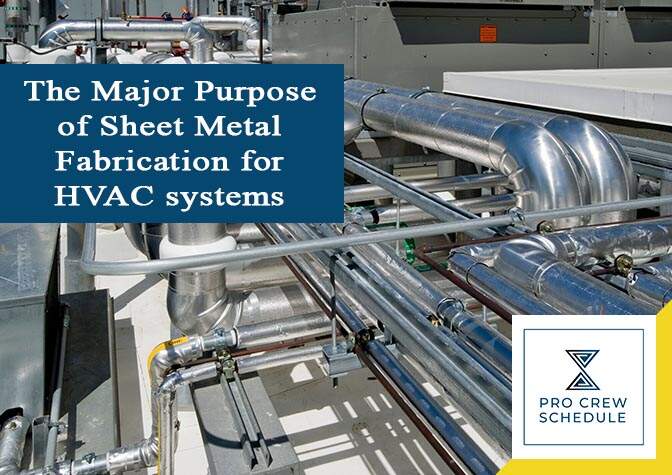An HVAC system is a complex assembly that primarily relies on various parts working altogether seamlessly. Every system requires a unique and individualized approach to function well, while HVAC project leaders mainly used project management software to create a well-structured project plan. By default, the system is primarily responsible for distributing heat and air conditioning in any indoor space in the most efficient possible ways. In actuality, the existing ductwork in the system is made from sheet metal. This metal is purposely fabricated particularly for the system itself.
As an HVAC contractor, you most likely hear your clients asking what sheet metal is and what’s the exact purpose of it? In general, sheet metal is significant in the system since it is considered the most common material utilized for ductwork. It covers a variety of materials and has various uses in several industries, including HVAC and construction.
For this blog, sheet metals are best explained and also the fabrication process intended for it.
What is Sheet Metal?
Sheet Metal is a grand term for a metallic material’s thin sheet that will become a structure or a product through the fabrication process. This metal is a great choice for cooling and heating equipment because it improves duct design components’ performance. These sheet metal components are easy to install and can also provide strength, durability, and energy efficiency to endure environmental elements and high temperatures.
Here are the common materials used in sheet metals:
- Aluminum – due to its resistance to corrosion and lightweight, aluminum has become a tremendously popular option for ductwork. This material is proven to be reliable for both indoor and outdoor. Easy installation and bendable to fit in any shape are two of the significant advantages of aluminum.
- Galvanized Mild Steel – one of the best duct designs for buildings is made from galvanized light steel with a rust-resistance zinc coating. This particular design is preferably used because it can be customized and can provide enough protection against air loss, thus lowering energy bills. The smooth quality of galvanized steel minimizes the airflow compared to the other duct materials.
- Stainless Steel – this material is another useful kind of sheet metal, especially for budget-conscious building owners. It provides the same amount of strength as galvanized steel and aluminum. It also has a high resistance to moisture and corrosion.
Every metal type is usually used for various products and different purposes based upon its resistance to strength, durability, and heat. Most of the HVAC systems installed by contractors nowadays, including the other parts and ductworks, are commonly made from either aluminum or galvanized steel.
A Breakdown of the Sheet Metal Fabrication Process
Installing a customized HVAC system only means that it’s not easy to grab all the parts off the shelf. The only solution for it is to use sheet metal fabrication. Doing so will help create the perfect features and components needed to execute the job. Fabrication is particularly beneficial when it comes to designing custom ductwork and plenums. So, how does the fabrication process for sheet metal exactly works?
1. Cutting
Obviously, sheet metal fabrication commonly begins with a huge sheet of galvanized metals. This sheet will be then measured and then marked accordingly to serve its purpose. HVAC installers will not cut the metal to the preferred size using several tools. The process of cutting the metal is called sheeting since it directly involves applying enormous force, causing the metal to shear.
Shears and sheet metal cutters are often used in the procedure. Other tools include non-powdered and powdered saws, torches, and chisels. CNC plasma cutters are also consistently used to produce precise and quick cuts. HVAC professionals also prioritize project management for construction to achieve a systematized project planning.
2. Forming
Once the sheet metal pieces are finally cut to the correct size, the next step is to form these metal pieces to the ideal shape. Every piece should have a particular shape depending on the location and its function within the more extensive system. Some shaping is usually done using hand tools, but mechanical equipment is generally required. HVAC installers often used many tools and equipment at their disposal. This set of tools will help them obtain the exact shape they needed.
Here are some of the most common tools they will use during fabrication.
- Notching machines can shear sheet metal at accurate angles to create different corners.
- Folding machines are utilized to fold sheet metal at precise and sharp angles.
- Flange forming machines will press flanges into sheet metals so that joining is easier.
- Pneumatic mounting machines are utilized to form many corners from rectangular ducts.
- Shrimp bending machines will bend ducts and pipes to create elbow-shaped shrimp bends.
- Lastly, construction scheduling software to efficiently monitor the entire fabrication process.
Regardless of what tool is to be used, this process’s primary goal is to apply sufficient pressure to deform the metals without shearing. This forming process is where cut and flat sheets of metals are transformed into components needed for the job. Fittings and other essential pieces are also molded at this stage.
3. Assembling
Once all the essential pieces have been formed, the final task is to place them all together. The assembling stage is specifically vital to ensure that each part works as planned. Any poorly installed plenum and misaligned duct sections can hamper the whole HVAC system. This stage is also the best time for identifying any final adjustments that can maximize fit and efficiency. Using subcontractor scheduling software makes it easier for the team to collaborate with another, especially when figuring out the final adjustments.
The actual process of this stage often varies depending on the application. In most cases, the pieces are often joined together by welding. Other applications might use threaded fasteners, powerful adhesives, rivets, or a combination of the above. On the other hand, different assemblies may also require a final step termed as finishing. This last step is commonly involved in applying powder coat treatments.
Furthermore, sheet metal fabrication is generally used to create the ductwork that every HVAC system relies on. The sheet metal is often cut and burned into different shapes. In the end, the metals are blasted, painted, primed, and further customized to meet the client’s specifications. Yet, the ducts designed for HVAC are more prioritized since they offer a passageway for the air and ventilation purposes.
Why HVAC Systems Need Sheet Metal Fabrication?
Whether during warm summers or cold winters, the comfort inside any indoor space relies primarily on the sheet metal air ducts placed inside the HVAC system. Only HVAC professionals can ensure that the system will be working at its peak performance. Below are some valid reasons why HVAC systems specifically need sheet metal fabrication.
1. It fits in the project
Whether you’re establishing new structures, remodeling, or installing, sheet metal fabrication allows for a complete and customized HVAC system. The use of machines and computers only means that the pieces are cut, shaped, and designed precisely to your project’s specifications. When getting customization, two significant advantages are lessened errors and waste elimination, making the systems more efficient and money-saver.
Sheet metal fabrication has allowed HVAC contactors to match any existing ductwork when remodeling or constructing flawlessly. Since sheet metal fabrication can utilize many metallic mediums, a contractor can pick the best materials to match the new system components. Doing so, it’ll make air flows more efficiently.
2. It provides quality control
HVAC contractors are convinced that providing ductwork sheet metals will add a layer of quality control to the HVAC system. It is one of the many reasons HVAC professionals often convinced their clients to obtain sheet metal needs. When there are any problems with the HVAC system, particularly with the ductwork, HVAC professionals are called upon.
HVAC experts with broader experience in this area can help fabricate new ductworks and new parts to enhance or fix the system. They are the only ones that can troubleshoot any discovered issues that clients tend to experience in their system.
3. It saves money
In short, a built sheet metal ductwork system that is custom-designed provides a tight fit that is resistant to leaks. As a result, efficient airflow is achieved, and energy usage is reduced. Insufficient and leaking systems often result in higher energy bills and wasted energy.
The ductwork will be resistant to damage such as water and rust and will become more durable in the long term. An HVAC contractor can quickly fabricate pieces and parts when upgrading the system using the right tools. Yet, nothing can beat any HVAC professionals that have broad experience in fabrication. Costly repairs are completely reduced because custom sheet metal fabrication lessened HVAC systems’ likelihood breaking down before they have met their anticipated lifecycle.
Key Takeaways
A well-designed HVAC system is a vital component of any indoor place. A system tailored to meet the client’s specific needs can lower utility costs and eventually save tons of headaches in the long run. Sheet metal fabrication is truly a crucial part of ensuring the best fit and function. That is why it is equally essential for HVAC professionals to know about sheet metals and their fabrication processes.







